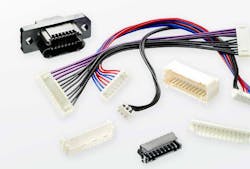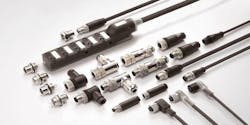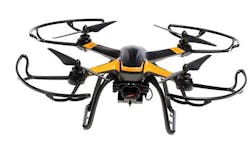Drone Technology Success Banks on Reliable Cabling and Connectors
Download this article in PDF format.
Since Austria first used bomb-filled balloons in 1849 to attack Venice, drones have become increasingly widespread in use and technologically sophisticated. Today, DMR Business Statistics predicts the number of drones set to take flight by 2020 will be roughly seven million. In effect, drones are now an industry.
As unmanned aerial vehicles (UAVs) become smaller and lighter in weight—translating to more efficient energy consumption and longer flight times—the requirements for connectors, interconnects, and cabling have also become more stringent. Similarly, interconnects and cabling need to be ruggedized and capable of withstanding the harsh operation of a drone, where extreme vibration, shocks, and heat are factors.
It’s not uncommon for drones to experience rough landings and fly through adverse weather. Under these conditions, electrical interference and turbulence come into play and have the potential to damage or destroy onboard electronics.
Although most hardware employed in UAVs is EMI-shielded, connectors that aren’t designed properly can cause those components to fail. All it takes is one compromised connection to effectively cripple an entire UAV, making robust and ruggedized connectors a priority for any aircraft.
Sponsored Resources:
Despite the myriad array of UAV types and configurations, all have the following sub-components:
- A fuel/power supply to keep them airborne (small UAVs typically employ lithium-ion polymer, or LiPo, batteries)
- A computing platform for processing data
- Sensors (both internal and external)
- Actuators/servomotors
- A communications platform and a software package
Every component in this list (whether modular or not) requires suitable cables and connectors to maintain reliable power and data transfer. The components must also withstand long life cycles, and in some cases, particularly in the case of modular components, withstand repeated plugging and unplugging. Specialized connectors and cabling are available for these components, with a variety of different seating, retention, termination, housing, and contact features to meet the specific needs of an application.
AMP CT connectors provide wire-to-wire or wire-to-board interconnects for panel-mount applications. (Credit: TE Connectivity)
The hardware design ultimately dictates the type of connector, which is true for any industry, including aviation. With the miniaturization of electronics, connectors can similarly be downsized, and their low-profile design helps mitigate the reduced space.
Sensor suites and onboard computing platforms also benefit from the smaller interconnects, including D-Sub and DT-style connectors to communicate data for cable-to-cable or cable-to-board applications while at the same time maintaining optional-sized pin configurations.
UAV Connector Applications
Myriad connectors correspond to essential UAV components. The six primary platforms of a UAV are communications, computing, lighting, power, motor, and sensing.
For communications, connectors need to maintain stable RF/RC and broad-bandwidth data flow without disruption, while also retaining rugged integrity. Backplane RF modules, fine-pitch board-to-board, coax, and M.2 connectors (like those for motherboard-based SSDs) work well here, and some can be customized depending on the need. TE Connectivity, for example, offers customer-configurable modular backend RF modules with different housings, number of coax connections, contacts, and adapters for RF applications.
For computing, drones rely on everything from full-avionics packages to single-board computers (SBCs) to process data such as navigation, sensor input, and flight functions. Some connectors used in these applicatinos are similar to those on desktop PCs, laptops, and SBCs. Others can be more complex, but they all maintain a level of ruggedness to withstand the environments. DDR3/4 memory connectors, hardened CPU sockets, insulation displacement connector (IDC) PCB wire-to-board/board-to-board, FFC/FPC (flat flexible cable/flexible printed circuit), and low-profile ATX (advanced technology extended) connectors fall into this group.
Like any aircraft, UAVs need signal lighting that’s mandated by the FAA for large drones and aircraft. Although regulations are still in development, most commercial and hobbyist drones are equipped with LED lighting.
When it comes to power, large drones, such as the U.S. military’s Reaper and RQ-180, gain most of their drive from aviation fuel and use battery backup for onboard avionics. Hobbyist and some commercial-grade UAVs rely strictly on Li-Po batteries and the same connection and switching options for system PCBs, including low-profile dc jacks; multi-directional interconnects, compact high-voltage relays, dip switches, and even USB connectors for peripheral add-on devices.
For motors and engines, connectors vary in size and range, but need to be robust to handle both engine and environmental conditions. Some of the types of connectors used here are horizontal interconnects—e-CON plug connectors for sensor terminations and PLCs, and PTL inter-device and EP power connectors with high-performance terminals and splices.
In any case, connectors encompass ruggedized FASTON terminals with a variety of crimping styles and shielding, push-grip connectors, CT connectors, COB LED sockets, and others with specialized locking systems that mate terminals and lock them in place. TE Connectivity’s Grace Inertia series is an excellent example of integrated locking systems that are able to handle the rigors of flight applications.
M8 and M12 are the go-to solutions for sensor connectors. (Credit: TE Connectivity)
Connectors for sensors are fairly standard across the board, with M8 and M12 being the go-to design for handling increased data communications and bandwidth (up to 10 Gb/s). The designs are simple and can be configured in a multitude of positions and terminal options for PCB headers, cable assemblies, and I/O boxes with locking mechanisms to secure them in place. These devices are designed with industrial applications in mind, making them an ideal choice for UAV sensor suites.
When it comes to hardware, there are many UAV connection and cabling options. Cabling needs to be able to survive in harsh environments without degradation to signal continuity. Most cabling options for UAV hardware are copper-based, whether coax, Ethernet, USB, or Fibre Channel. They also need to be lightweight and flexible, yet resistant to the elements (thermal, moisture, lightning, etc.), electrical noise and EMI interference. These cables mostly consist of a copper core surrounded by a dialectic insulator, a copper/aluminum metallic shield, and polymer outer casing. They’re available in many form factors, including ribbon, coax, and CAT.
Do They Meet Standard Requirements?
As with all hardened connectors and cabling, these products must meet rating standards, the most common of which is IP (International Protection/Ingress Protection). These standards dictate a series of digits that indicate the amount of resiliency a component has for particle or liquid ingress, with the first digit denoting particle protection and the second liquid. For example, an IP rating of 58 is dust-resistant and can be submerged in 1.5 meters of fresh water. In short, the higher the number, the better the protection.
The military employs a higher standard rating for its connectors, known as the MIL-STD (Military Standard), which encompasses electrical, fiber optic, and alternative applications. These roll with two sets of letters and a set of numbers to denote type and protection level.
The first set of letters are designated MIL for the military; the second set of letters indicates type; and the set of numbers indicates protection level. For example, a rating of MIL-DTL-5051 describes a circular connector that features solder or removable crimp contacts and has an operating temperature range of −67 to 392°F, depending on the class of the connector.
There are also ANSI/VITA standards for framework bus computer architecture and electrical current rating, and some connectors and cabling will need to meet them. The ratings are expansive, covering everything from DIN connector pins to I/O modules and everything in between.
These ratings are listed in groups of three numbers denoting specification, year, and application. For example, an ANSI/VITA rating of 1.7-2003-(52014) lists the P1/J1 and P2/J2 current rating limits of the three-row DIN and five-row DIN connector pins that are capable of passing 2.0 A per contact on a selected group of pins.
Connectors for drones will continue to evolve along with the latest technology. (Credit: TE Connectivity)
What’s next for UAV connectivity, especially when it comes to technology advances? Higher communications bandwidth with ever-increasing throughput, more sophisticated sensors, ever-evolving CPU power, networks, and efficient motor design will influence how connectors and cabling evolve.
Modularity of hardware will also be a factor as swap-out platforms become increasingly mainstream. Interconnects with a wide range of impedances will continue to evolve in order to reduce the number of types and cables needed for applications. Universal compatibility will undoubtedly become the next standard in UAV platforms.
The next step for UAW connectivity? It’s seemingly up in the clouds.
Sponsored Resources:
Related References:




